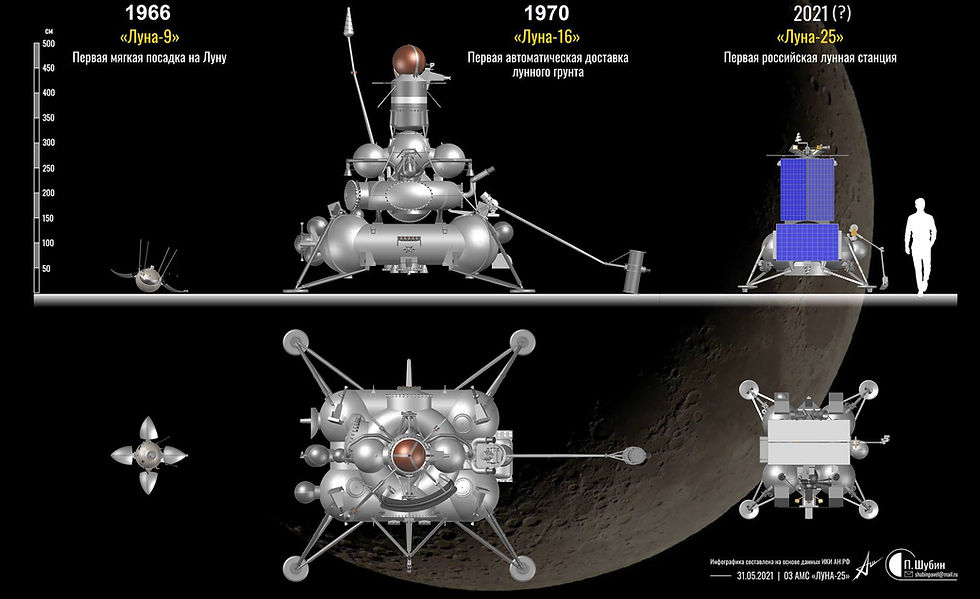Russia's inaugural lunar probe launch after 47 years.
- Karthik Naren
- Aug 10, 2023
- 4 min read
Luna-25 will take off from Vostochny with the mission to land on the south pole of the Moon

The launch of the 14A14 Soyuz 2.1b/Fregat rocket n° V15000-003 with the Luna-25 automatic lunar station is scheduled for August 11, 2023, at 02:10:57 Moscow time, 08:10:57 Vostochny, 23:10:57 UTC on the 10th. The rocket will take off from platform 1S of the Vostochny Cosmodrome. This will be the first Russian lunar mission after a long break – the last Soviet Luna-24 automatic station was launched in 1976.

The 1.8-tonne Luna-25 / Luna-Glob is more than three times lighter than its predecessors due to a number of technical solutions. The landing station will analyze the composition of the lunar soil and transmit this information to Earth.
The mission will be a new step in the development of exploration of the Earth's natural satellite: the landing is planned in the vicinity of the South Pole of the Moon to study the lunar regolith and exosphere, which is currently inaccessible to humans.
The Primary Landing site is located in the Boguslavsky crater, the Coordinates are 69.54°South, 43.54°East and two reserve ones: southwest of the Manzini crater (marked in red) and south of the Pentland A crater (marked white)

Its goals can be divided into technical and scientific ones. At the moment, almost half a century has passed since our last mission to the moon - the Luna-24 lander. In the 21st century, no one has successfully landed on the moon, except for the Chinese. Even the Americans did not sit down, their program kept sliding to the right, closed, and changed. During this time, several generations of engineers have changed. So a full-fledged experience is lost, and not only with us. - says Maxim Litvak Professor of the Russian Academy of Sciences, Doctor of Physical and Mathematical Sciences, Head of the Laboratory of Neutron and Gamma Spectroscopy of the Department of Nuclear Planetology, IKI RAS
He emphasized that the device will not just land where no one has landed and where there are interesting areas with a high content of water ice and volatile compounds. The main thing is to fully explore these areas. To do this, a self-consistent set of scientific instruments was selected on Luna-25.
The project is included in the Russian Federal Space Program for 2016–2025 (ROC Luna-Glob) is aimed specifically at studying the soil, so most of the mass of scientific equipment is reserved for this purpose. It must also be remembered that the payload mass is not so much, only about 30 kg, so other scientific instruments were selected very carefully.

The landing module instruments:
ADRON-LR, regolith active neutron, and gamma-ray analysis
ARIES-L exosphere plasma measurement
LASMA-LR, LIS-TV-RPM laser mass spectrometer mineral infrared spectrometry
PmL imaging, dust, and micrometeorite measurement
THERMO-L, measurement of thermal properties of regolith
STS-L camera, panoramic and local imaging
Retroreflective laser, lunar libration and
BUNI range experiments energy data support and science research
The work of Luna-25 will continue for at least an Earth year, with the help of Solar Cells and RITEG, a 238Pu plutonium-238 dioxide system that will provide direct thermal protection for instruments during the hibernation period in Lunar nightfall, and indirectly provides electrical power via thermocouples. during its operation, the scientists will carefully study the regolith on a small piece of the Moon's surface near the spacecraft and to depths of a few tens of centimeters.

To study the distribution of ice on Luna-25, there is an ADRON-LR neutron and gamma spectrometer, which can carry out such an analysis for the presence of water ice remotely. But - most importantly - the station has a manipulator LMK (short for "lunar manipulator complex"), capable of excavating regolith and taking samples of it.
LMK will be able to deliver the soil directly to the LAZMA-LR laser mass spectrometer. In addition, the LIS-TV-RPM infrared spectrometer is installed on the manipulator, with which you can “look” into the excavation or dumps and also try to find water ice.
An interesting task that is directly related to the further exploration of the Moon is the study of lunar dust. For this purpose, the PML device (short for "dust monitor of the moon") is intended. It does not weigh that much, just over a kilogram, and its results will be very useful. If you work on the Moon for a long time, then dust along with radiation can bring a lot of trouble to both people and technology.
Finally, the ARIES-L instrument will study the lunar exosphere. This is a very, very rarefied shell around the Moon, consisting of ions and neutral atoms. It is very interesting to measure their energies and concentrations at a new point for us - not on the equator, but in the polar region.

Summary

Its main objectives are:
Soft landing on the Moon in a selected area in the South Subpolar Region (SPL)
Development of technology for working on the lunar surface and survival of the spacecraft on a lunar night to ensure the operation of onboard equipment and a complex of scientific equipment for one year
Achievement of scientific research on the composition and structure of regolith and study of the Moon's exosphere by remote and contact methods
Main scientific tasks:
Survey of water and volatile compounds in the lunar polar matter, the study of the elemental and isotopic composition of the surface and upper layer of polar regolith
Studies of the plasma and dust components of the lunar exosphere near the surface, including the interaction of the solar wind with the upper layer of the lunar regolith
Scientific and technological tasks:
Constructing a surface heterogeneity map to test high-precision and safe spacecraft landing systems for future lunar projects
Study of physical and mechanical properties of regolith

Flight Profile
Soyuz flight (Launch Profile)

Launch to LOI

Moon Landing

Live Stream:
























Comments